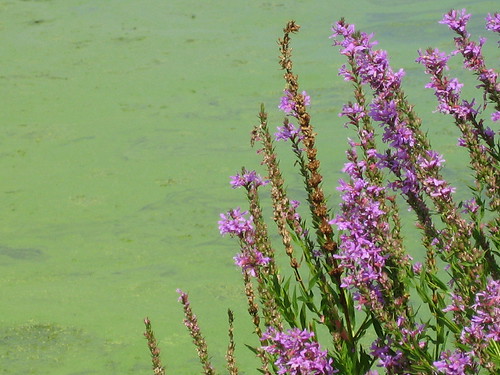
Purple Loosestrife, originally uploaded by cambodia4kidsorg
Popular opinion has treated the invasive plants as botanical illegal aliens. The Environmental Protection Agency has labeled them as the second-greatest threat to the continent’s biodiversity, exceeded in their impact only by outright destruction of habitat. Major resources have been devoted to the spraying and rooting-out of invasive plants in the belief that their removal would enable an ecological revival. Roughly $45 million, for example, is spent every year in the unsuccessful attempt to stop the spread of a single European wetland weed, purple loosestrife (Lythrum salicaria).
New research, however, suggests that invasive species, at least in some instances, aren’t so much the causes of environmental degradation as eco-opportunists taking advantage of disturbed habitats. Or, as the biologist Andrew MacDougall of the University of Guelph, Ontario, puts it, the invasives may behave more as “passengers” than as “drivers.”
From Can Weeds Help Solve the Climate Crisis? (NYTimes.com)
I’ve been involved in the past with the Western Pennsylvania Conservancy, a wonderful organization that maintains Fallingwater and acts as custodian for natural resources in this state. Several years ago, I attended a workshop on exotic invasive plants, like purple loosestrife, multiflora rose, orange day-lily, and English ivy among many others, and participated in a project to remove purple loosestrife from a stream near here. It was hard and discouraging work: We spent a day carefully cutting off and bagging plants, but made barely any impression in the space.
One frequently cited definition is that a weed is “a plant out of place.” Many of the invasive exotics were brought here originally by well-intentioned gardeners and home owners. Purple loosestrife is rather pretty, for example. But because these plants proliferate so quickly and widely, we view them as weeds.
Now I read in this article in the NY Times that removal efforts like the purple loosestrife project I worked on may indirectly hasten the decline of native species in the area:
For three years [biologist Andrew MacDougall of the University of Guelph] removed the invasive grasses from plots he outlined within [a Nature Conservancy Canada property on Vancouver Island]. In some plots, he did this by mowing or burning; in others, he removed the weeds entirely. Yet the native flora didn’t rebound significantly. In some cases, the decline of the native plant species instead accelerated, and the fundamental character of the flora within the plots began to change, with woody plants encroaching on the formerly open, grassy areas.
MacDougall concluded that rather than serving as drivers of change, the foreign grasses were functioning more in the role of passengers, merely filling in as the natives disappeared. In fact, the foreigners seemed to be serving a stabilizing role. By blocking light from reaching the soil, they inhibited the germination of tree and shrub seeds. Keeping the brush at bay in this fashion preserved the open character of the savanna habitat so that the remnants of the original savanna wildflowers, grasses and wildlife could at least survive. In light of these findings, MacDougall says, he came to believe that the primary cause of the native flora’s decline was human intervention. Before European settlement, fire periodically cleansed the soil surface of dead plant material. Suppression of fire since settlement had allowed a thick layer of litter to accumulate, and the foreign grasses cope better with this than do the natives.
This theary makes sense, yet it also raises the question of what we should do — or not do. It seems impossible to think of not trying to remove fast-growing plants; it’s too easy to imagine a South consumed by kudzu. But until we can find ways to reduce our production of carbon dioxide (which seems to encourage the growth of many other unwelcome plant species), we may find we need to lean on certain invasives to help us preserve other species.
Suddenly, these plants no longer seem quite like weeds any more.
That clip about Vancouver Island is really interesting. I would have never thought of weeds as helping native plants.
Instead of a party for her Bat Mitzvah celebration, my daughter chose to invite her guests to a local (SF Bay Area) nature preserve and work on habitat restoration. They’ve had remarkable success with the work so far, both at this preserve and in the various parts of the SF Baylands.
We pulled non-native plants, and seeded native ones. All the work was done by hand, removing the plants at their roots. This is similar to the Baylands work I did a few years ago, restoring the habitat.
I wonder what’s different between the Vancouver work and the work occurring here.
AMM: What an interesting choice your daughter made! I’m curious what was different between the Vancouver project and what you’ve seen in the SF Baylands. I also know that the scientists who work with the Western PA Conservancy have reported that the removal projects here create positive results for the native plants. Maybe it has to do with the scale of the removal efforts?
Yes, perhaps with the scale, perhaps with the rest of the surrounding ecosystem, perhaps with roughly matched re-planting efforts, perhaps something entirely different!